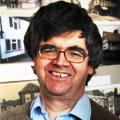During the lockdown, I have been cataloguing some photos on behalf of the Vale and Downland Museum in Wantage.
Among them have been a series of photos of the Garston Lane Baptist Chapel which was demolished in 1936.
This was because – according to a local newspaper of the time – the chapel was in danger of collapse due to heavy traffic passing by in Garston Lane.
The Baptist Church in Mill Street, which was built in 1860, is the last in a succession of buildings used by the church in Wantage.
The first was the timber framed Market House or Town Hall which stood in the middle of the Market Place in the 17th century.
Before that, they may have worshipped secretly in one another’s houses and barns.
A barn was certainly their next permanent home, a building which stood on the north side of Garston Lane within the old Baptist Burial Ground.
The building dated from 1649, and the first Baptist minister in Wantage was Robert Keate who moved to Wantage from Reading.
It is at this point that Robert Stiles (who later gifted the Almshouses that bear his name in Newbury Street) comes into the story.
A wealthy merchant originally born in Wantage, but who made his money in Amsterdam, it was he who gave Dr Elias Clark – one of the deacons of the Baptist church – £500, which was spent in purchasing the barn then used as a chapel in the freehold site of the Garston Lane burial ground and in the purchase of a farm at Inkpen from which was derived the income for paying the ministers and repairing the chapel.
A record book kept by the church at the time gives details of incidental expenses:
1lb candles 7d; costs 6d; Mr Arputt for repairs 10d; two latches for door 1s; paid ringer for stooping bell 1s; 3½d for candles for ye lectures and 3d 'for lad showing Mr Evans the way'.
Instances of recorded discipline in connection with the church, either in the case of ministers or members, are few, but in 1743 a member was cut off for 'intemperance and riotous living' and in 1762, it was resolved that 'a member be suspended … for keeping goods of another member and not returning things but appropriating to his own use and other unseemly walk and behaviour, till he makes restitution and promises better and more ornamental conduct'.
It is believed that at some point John Bunyan came to preach in this little chapel (I have not been able to ascertain when) but he may have used the pulpit shown in the interior photo taken in the 1930s here.
In 1771 the community took over a chapel in Back Street (now Church Street) and later established a church in Grove.
The present Baptist Church in Mill Street was built in 1860 at a cost of £1,519, the foundation stone being laid by Mr T Liddiard and was opened in the following November.
If one walks along Garston Lane today, one can see where the old chapel used to stand, by peering over the wall or through the gate as there is a large clear space before one gets to the gravestones, the earliest of which dates back to 1692.









Comments: Our rules
We want our comments to be a lively and valuable part of our community - a place where readers can debate and engage with the most important local issues. The ability to comment on our stories is a privilege, not a right, however, and that privilege may be withdrawn if it is abused or misused.
Please report any comments that break our rules.
Read the rules here